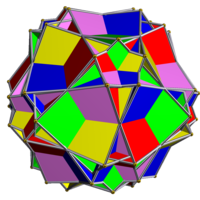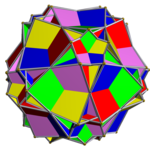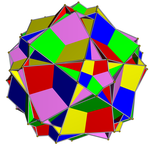| Compound of five cubohemioctahedra | |
|---|---|
 | |
| Type | Uniform compound |
| Index | UC60 |
| Polyhedra | 5 cubohemioctahedra |
| Faces | 30 squares, 20 hexagons |
| Edges | 120 |
| Vertices | 60 |
| Symmetry group | icosahedral (Ih) |
| Subgroup restricting to one constituent | pyritohedral (Th) |
This uniform polyhedron compound is a composition of 5 cubohemioctahedra, in the same arrangement as in the compound of 5 cuboctahedra.

